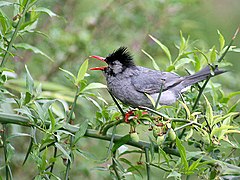Hypsipetes
| Hypsipetes | |
|---|---|
 |
|
|
Black bulbul (Hypsipetes leucocephalus psaroides) Kullu district, Himachal Pradesh (India) |
|
| Scientific classification | |
| Kingdom: | Animalia |
| Phylum: | Chordata |
| Class: | Aves |
| Order: | Passeriformes |
| Family: | Pycnonotidae |
| Genus: |
Hypsipetes Vigors, 1831 |
| Diversity | |
| About 10 species, but see text | |
| Synonyms | |
|
Anepsia Reichenbach, 1850 (non Gistel, 1848: preoccupied) |
|
Anepsia Reichenbach, 1850 (non Gistel, 1848: preoccupied)
Cerasophila Bingham, 1900
Haringtonia Mathews & Iredale, 1917
Ixocincla Blyth, 1845
Hypsipetes is a genus of bulbuls, songbirds in the family Pycnonotidae. Most of its species birds occur in tropical forests around the Indian Ocean. But while the genus is quite diverse in the Madagascar region at the western end of its range it does not reach the African mainland.
Most Hypsipetes bulbuls are dark greyish birds with range or red bills and feet. The feathers on toip of the head are slightly elongated and usually black, and can be erected to form a short and wispy crest.
The following species are provisionally placed here:
The mountain bulbul and Sunda bulbul – formerly H. mcclellandii and H. virescens – are provisionally placed in Ixos until the genus limits in bulbuls are firmly established. They are often included in Hypsipetes but this is an old error that was promoted in modern times by the Sibley taxonomy.
In fact, I. virescens is the type species of Ixos, and though some sources advocate a complete merger of the two genera – and even the entire "Hypsipetes group" of bulbuls, which also includes Hemixos, Iole, Microscelis and Tricholestes –, being the oldest genus name Ixos would apply to all of them, rather than Hypsipetes as is often believed. The most drastic course hardly appropriate however, since Alophoixus and Setornis cannot be excluded from the "Hypsipetes group", and an all-out merge would turn the resultant "genus" into an ill-defined "wastebin taxon". The erroneous inclusion of I. virescens in Hypsipetes has caused the Nicobar bulbul to be listed under its invalid junior synonym H. nicobariensis rather than the valid names H. virescens or I. nicobariensis.
...
Wikipedia
